-

人教版新目标初中英语八年级上册What’s the best radio station教案2篇
教学重点和难点:运用所掌握的语言描述,比较不同地点的特点。在练习中学习掌握英语比较级和最高级的用法。课前准备分配小组,每组五至六人。通过上网或翻阅报刊杂志等方法,确定旅游线路,做出基本的旅游计划。教学设计:本节课流程图 学法指导:1.由于这是一堂新课,在教学中应注意面向全体,发挥学生的主体性,引导学生积极参与,激发学生的求知欲和学习积极性,指导学生积极思维,主动获取知识,养成良好的学习方法。逐步学会独立解决问题。总之要尽可能调动学生的非智力因素促进智力因素的发展。教法选择:1.电化教学法2.课堂讨论法3.任务型教学法采用这些方法的目的是为了充分调动学生的学习积极性,使学生变被动学习为主动学习。通过电脑形象的演示,加强印象,提高兴趣,突破难点,提高教学效率,进而增大教学的容量和信息量。充分体现教师为主导,学生为主体的教学原则。

人教版新目标初中英语九年级上册How do you study for a test教案2篇
内容提示本单元主要内容是学会利用verb十by/with gerund表示方式方法来讨论学习英语的策略,认识自己在学习方面的长处和不足。初步了解现在完成时的结构和用法。现在完成时由助动词have/has+动词的过去分词构成,主要表示过去发生的某一动作对现在仍有影响或造成的后果,常与already,yet,just,ever,never等副词连用。教学目标一、学习目标(Language Goal) 1. Talk about how to study . 学会讨论各种学习方法和策略。2. Find out your suitable learning methods. 找出适合自己的学习方法。 二、语言结构(Language Structures) 1. Verb + by with gerund by+动名词短语 表示“通过…途径,方法” 2. How questions have引导的特殊疑问句 三、目标语言(Target Language) 1. How do you study for tests ? 你是怎样准备考试的?Well , I study by working with my classmates. 哦,我和同学们一起学习。2. Have you ever studied with a group ? 你曾经参加过学习小组吗?Yes , I have . I’ve learned a lot that way . 是的,参加过。通过这种方式我学了许多。

人教版新目标初中英语九年级上册Where would you like to visit教案2篇
The First PeriodⅠ.Teaching Aims and DemandsKnowledge Objects(1) Key Vocabularytiring, educational, fascinating, thrilling, peaceful, exotic, trek, jungle, take it easy, explore, historic, site(2) Target LanguageWhere would you like to go on vacation?I’d like to trek through the jungle, because I like exciting vacations.2. Ability Objects(1)Train students to talk about places they would like to visit with the target language.(2)Train students to describe vacations with different adjectives.(3)Train students' listening skill.3. Moral Object,It′s more interesting to go on vacating somewhere instead of staying at home.Ⅱ. Teaching Key Points1. Key Vocabularytiring, educational, fascinating, thrilling, peaceful, exotic, trek, jungle, take it easy, explore, historic, site2. Target LanguageTalk about different places with the target language.Ⅲ. Teaching Difficult Points1. Describe vacations with different adjectives.2. Talk about different places with the target language.Ⅳ. Teaching Methods1. Teaching by illumination2. Teaching by doing chain drills3. Teaching by pairworkⅤ. Teaching Aids1. A tape recorder2. Some pictures of different places with famous views

人教版新目标初中英语八年级上册How do you make a banana milk shake教案2篇
1. First, ... then, ... next, ... finally, ...首先,……然后,……接着,……最后,……这是英语中表达做某事的步骤的一种说法。如果步骤较多,还可以说:first-next-after that-later on-finally/at last通常你会听到说英语国家的人在说 first, next, then, finally 和后面的内容时,他们会做一些停顿。这样就能提前告诉听者接下来讲的是一系列的步骤。这一点在朗读和听力中应特别注意。2. how many, how much均为疑问词,同是“多少”,但用法不同。请看:how many修饰可数名词复数,how much修饰不可数名词。但在用法上,同学们常犯如下错误:1) [误] How many are there bananas on the table?[正] How many bananas are there on the table?[析] how many, how much 中的many,much是形容词,常修饰名词作定语,故后面跟名词。2) [误]How much tea are there on the table?[正]How much tea is there on the table?[析] how much修饰不可数名词时,谓语动词用单数。how many与how much的区别可简记为:前how many:问“多少”,复数名词后面跑;how much问“多少”,不可数名词单数好。前者答语用基数词,后者答语用数量关系。

人教版新目标初中英语八年级上册How was your school trip教案2篇
“Go for it!” is based on “Task-Based Language Teaching”. It adheres to “The authenticity principle”, “The form-function principle”, “The task dependency principle” and “The principle of learning by doing”. These principles all accord with the demands of curriculum focus.In and of Grade Seven (II), “Go for it!”, students have learned “The Simple Past Tense”. And it appears again in of Grade Eight (I). teaches students more about how to talk about events in the past. In addition, it gives affirmative and negative statements in the past tense, such as the sentence patterns “Did you see …?” “Were there …?” “Did you go …?” As the first part of Unit 8, Section A opens with a picture presenting the last school trip in the aquarium and continues with several step-by-step practice activities, which are all good for students to master “The Simple Past Tense”. Doing well in Section A will help students integrate the new target language with that in Section B. Thus, they can describe the events in the past freely and foster their own ability of reflecting and practicing. II. Teaching ObjectivesTeaching objective is the beginning and aim of teaching activities. According to the overall goal of the English elementary course--- improve students' synthetic ability of language application, which should be based on the development of students’ “Language knowledge”, “Language skills”, “Character building”, “Learning strategies” and “Cross-cultural awareness”. The teaching objectives are described as follows(I). Knowledge objectivesi. Master the simple past tense of regular and irregular verbsii. Recite the new words and expressions about the last school trip in the aquarium, including their pronunciation and intonation

人教版新目标初中英语八年级上册What are you doing for vacation教案2篇
Teaching goals : 1. Words & phrases: babysit ,get back , fishing , rent , think about , decide(on) , tourist etc. 2. How to talk about future plans . 3. 现在进行时表示将来计划或行动. 4. 特殊疑问句(where , when , how long引导) Important and difficult points : Drills :What are you doing for vacation ? I’m watching TV . When are you going ? I’m going … . How long are you staying ? We’re staying for five days . Teaching aids : cards and a tape ,a large wall calendar . Period 1 Teaching procedures : Step 1Leading in1. Free talk . 2. Put up the wall calendar . T: I’m staying home on Saturday (pointing to next Saturday ).Ss repeat . Ss: I’m staying home on Saturday . T: OK. Today we’ll learn how to talk about future plans. Step 2Pre-task SB Page 13 , 1a . 1. Look at the picture carefully and tell what you see in the picture . 2. Write the activities from the pictures in the box and add some more . 3. Practice reading . Step 3While-task1. Using the activities we write in 1a to make conversations .For example :What are you doing for vacation ? I’m visiting my uncle . 2. Pairwork .Practice in pairs . 3. 用第三人称练习对话.

人教版新目标初中英语八年级上册What’s the matter教案2篇
She shouldn’t go to the party tonight.Step7. TaskT: You know, there are lots of problems in our life. If you are a doctor, please tell us how to solve the problem. I will divide you into 9 groups. Please work in groups. And then choose one of you to report your ideas.The following are the problems:I have a toothache.I am hungry. I have a sore throat.I am stressed out. I have a sore back.I am tired. I can’t sleep.I have a cold. I have a headache.Report: If you have a headache, you should go to bed early. You should see the doctor. You should eat some medicine. You shouldn’t wash your face with cold water.You shouldn’t sleep late.You shouldn’t swim.…..T encourages the students to give advice as much as possible.Homework:1. Chose one of the problems, and write down your advice2. Copy the new words这一步是用于热身的,同时也可以让他们复习一部分的表示人体部位的单词,扩充知识.学习语言的过程也是一个不断积累的过程,复习旧知识,增添新知识.通过小游戏,强化学生对Does she/he have…这个句子的运用能力.通过复习,自然的引到下面新知识的学习。充分利用表格,由句子到对话,再到文章,让学生循序渐进. 提高学生的综合语言运用能力,运用以前学过的知识来解决身边的问题.Period 5 (Section B 3a—3c, selfcheck)教学内容与分析:

人教版新目标初中英语九年级上册Teenagers should be allowed to choose their own clothes教案2篇
Step 1 Greeting Greet the class and check the homeworkStep 2 A duty report The S on duty gives a report on the rules in his home and lead in 3a “Sun Fei’s and Wu Yu’s rules” Step 3 ReadingSs read the conversation and write the two girls’ rules in the chart. Check the answers.Get Ss to read after the tape and then read aloud by themselves. Then, T explains the language points.Step 4 Pairwork 3bRole play. Use the information in chart to practice with the conversation in 3a covered. They can look at the sample conversation in the right box.Step 5 Task 2 “Who’s the best reporter?”Make a survey by asking any 5 students the questions in the chart in activity 4. Then give out a report about it. See who is the best reporter? And the best reporter will get a nice ball-pen.Step 6 Summary and homework:Write out the report in your exercise-books.Period ThreeStep 1 Greeting and a duty reportThe S gives a duty report talking about his experience of being late for school. Lead in the question “Do you ever get to school late? How often do you get to school late? Always, usually, sometimes, or never?Step 2 1a Get Ss to finish writing.Step 3 Pairwork 1b Get Ss to talk about their answers with their partners using the sample conversation in the box on the right.Step 4 Listening practice2a Lead-in: What will happen if you get to school late? What about Peter? Let’s listen to a conversation between Peter and his father. Get Ss to finish 2a (As usual, for the first time, Ss only listen.) Check the answers.
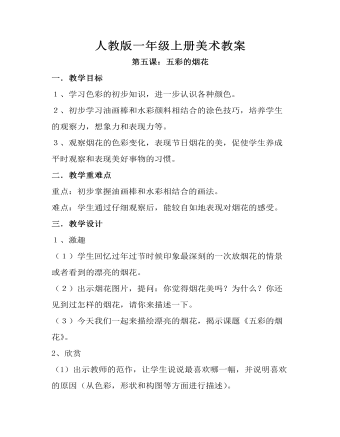
小学美术人教版一年级上册《第5课五彩的烟花》教案
二.教学重难点重点:初步掌握油画棒和水彩相结合的画法。难点:学生通过仔细观察后,能较自如地表现对烟花的感受。三.教学设计1、激趣(1)学生回忆过年过节时候印象最深刻的一次放烟花的情景或者看到的漂亮的烟花。(2)出示烟花图片,提问:你觉得烟花美吗?为什么?你还见到过怎样的烟花,请你来描述一下。(3)今天我们一起来描绘漂亮的烟花,揭示课题《五彩的烟花》。
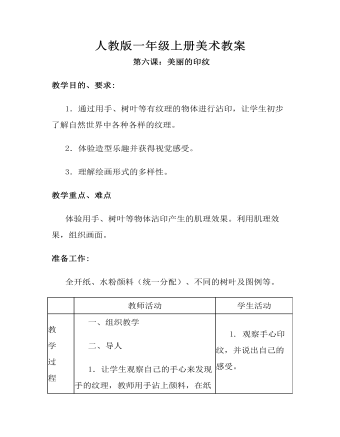
小学美术人教版一年级上册《第6课美丽的印纹》教案
3.让学生讨论并说说除了手之外,还可以用什么东西来印。三、布置作业1.团结协作;2.注意卫生;3.比一比,哪一组印得最美丽。
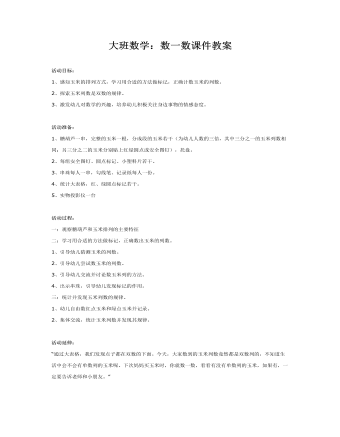
大班数学:数一数课件教案
2、探索玉米列数是双数的规律。3、激发幼儿对数学的兴趣,培养幼儿积极关注身边事物的情感态度。 活动准备:1、糖葫芦一串,完整的玉米一根,分成段的玉米若干(为幼儿人数的三倍,其中三分之一的玉米列数相同;另三分之二的玉米分别贴上红绿圆点或安全图钉),托盘。2、每组安全图钉、圆点标记、小塑料片若干。3、串珠每人一串,勾线笔、记录纸每人一份。4、统计大表格,红、绿圆点标记若干。5、实物投影仪一台
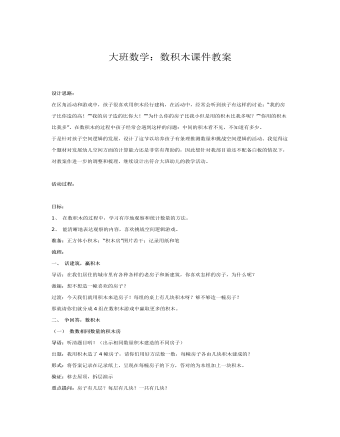
大班数学:数积木课件教案
活动过程: 目标: 1、在数积木的过程中,学习有序地观察和统计数量的方法。 2、能清晰地表达观察的内容,喜欢挑战空间逻辑游戏。 准备:正方体小积木;“积木房”图片若干;记录用纸和笔流程:一、话建筑,赢积木 导语:在我们居住的城市里有各种各样的老房子和新建筑,你喜欢怎样的房子,为什么呢? 激趣:想不想造一幢喜欢的房子? 过渡:今天我们就用积木来造房子!每组的桌上有几块积木呀?够不够造一幢房子? 那就请你们就分成4组在数积木游戏中赢取更多的积木。二、争回答,数积木 (一)数数相同数量的积木房 导语:听清题目哟!(出示相同数量积木建造的不同房子) 出题:我用积木造了4幢房子,请你们用好方法数一数,每幢房子各由几块积木建成的? 形式:将答案记录在记录纸上,呈现在每幢房子的下方,答对的为本组加上一块积木。 验证:移去屋顶,拆层演示 重点提问:房子有几层?每层有几块?一共有几块? 小结:数量相

中班数学:编号课件教案
准备 1.每组一套l~5的数字卡片。让幼儿自愿结合,每组5人,要高矮不同。 2.周围环境中有适于幼儿按大小排序的物体。每人一套l~5的数字卡片。 过程 活动(一)小朋友排队编号 1.排队编号。请幼儿从矮到高排队编号。教师交代:每组幼儿从矮到高排队后,报数编号,每人按编号领取相应的数字卡片。幼儿分组排队编号并互相交流,说一说:“自己这队小朋友是怎么排的队?自己排在第几?其他人排在第几?” 2.从高到矮排队编号,方法同上。 3.幼儿讨论。教师提问:“两次排队有什么不同?你都排在第几个?为什么?如:从矮到高排,明明排第1,从高到矮排,明明排第5。明明两次排队位置不同,这是为什么?”
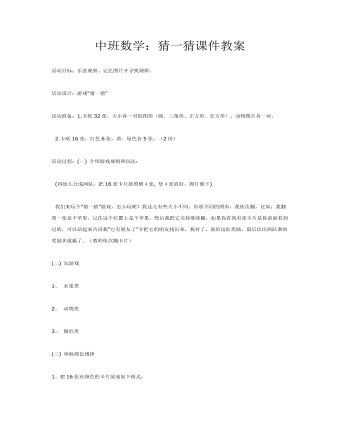
中班数学:猜一猜课件教案
活动设计:游戏“猜一猜”活动准备:1.卡纸32张,大小各一对的图形(圆、三角形、正方形、长方形)、动物图片各一对。 2.卡纸16张,红色6张,黄、绿色各5张。(2份) 活动过程:(一) 介绍游戏规则和玩法: (将幼儿分成两队,把16张卡片按照横4张, 竖4张放好。图片朝下) 我们来玩个“猜一猜”游戏,怎么玩呢?我这儿有些大小不同、形状不同的图形,我依次翻,比如:我翻第一张是个苹果,记住这个位置上是个苹果,然后我把它关掉继续翻,如果你看到有张卡片是你前面看到过的,可以站起来告诉我“它有朋友了”并把它的朋友找出来,找对了,就给这队奖励,最后比比两队谁的奖励多就赢了。(教师依次翻卡片)
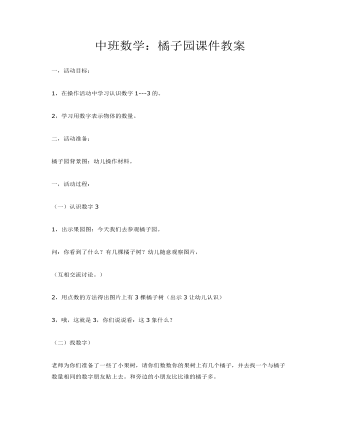
中班数学:橘子园课件教案
2,学习用数字表示物体的数量。二,活动准备:橘子园背景图;幼儿操作材料。一,活动过程:(一)认识数字31,出示果园图:今天我们去参观橘子园。问:你看到了什么?有几棵橘子树?幼儿随意观察图片,(互相交流讨论。)
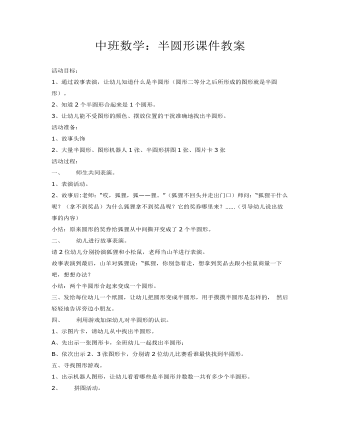
中班数学:半圆形课件教案
2、知道2个半圆形合起来是1个圆形。3、让幼儿能不受图形的颜色、摆放位置的干扰准确地找出半圆形。活动准备:1、故事头饰2、大量半圆形、图形机器人1张、半圆形拼图1张、图片卡3张活动过程:一、 师生共同表演。1、表演活动。2、故事后:老师:“哎,狐狸,狐——狸。”(狐狸不回头并走出门口)师问:“狐狸干什么呢?(拿不到奖品)为什么狐狸拿不到奖品呢?它的奖券哪里来?……(引导幼儿说出故事的内容)小结:原来圆形的奖券给狐狸从中间撕开变成了2个半圆形。二、 幼儿进行故事表演。请2位幼儿分别扮演狐狸和小松鼠,老师当山羊进行表演。故事表演到最后,山羊对狐狸说:“狐狸,你别急着走,想拿到奖品去跟小松鼠商量一下吧,想想办法?小结:两个半圆形合起来变成一个圆形。

中班数学:动物瓶课件教案
2.引导幼儿积极地与材料互动,培养良好的操作习惯。3.让幼儿体验数学活动的乐趣。活动准备:学具:空塑料瓶若干,黄豆若干,1-7不同数量的实物纸条,1-6的数字一组一份。教 具:1-6的数字卡、1-6的加点卡、动物图卡、大瓶子、背景图、头饰(火车头)、磁带。活动过程:1、以开火车游戏激发幼儿活动的兴趣。老师拿点子、数卡、动物图卡和孩子们进行问答游戏。师:嘿嘿,我的火车几点开?(师随机出示6以内的点卡、数卡)幼:嘿嘿,我的火车几点开。师:嘿嘿,来了几位小客人?(出示动物卡片)幼:嘿嘿,来了几位小客人。(反复进行几次)
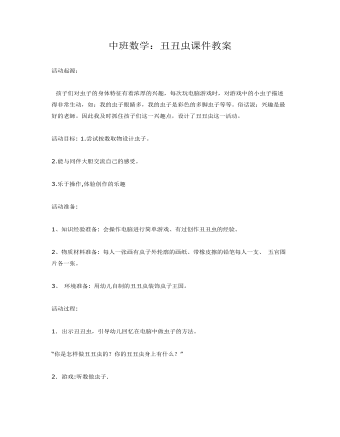
中班数学:丑丑虫课件教案
活动目标: 1.尝试按数取物设计虫子。2.能与同伴大胆交流自己的感受。3.乐于操作,体验创作的乐趣活动准备: 1、知识经验准备: 会操作电脑进行简单游戏、有过创作丑丑虫的经验。2、物质材料准备: 每人一张画有虫子外轮廓的画纸、带橡皮擦的铅笔每人一支、五官图片各一张。3、环境准备: 用幼儿自制的丑丑虫装饰虫子王国。
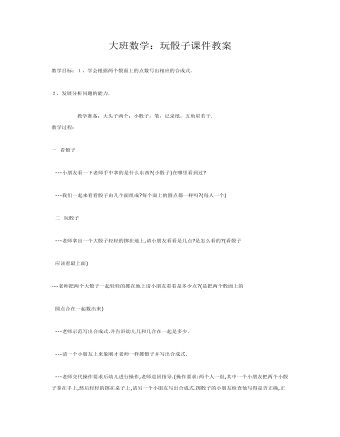
大班数学:玩骰子课件教案
2,发展分析问题的能力. 教学准备:大头子两个;小骰子,笔,记录纸,五角星若干.教学过程:一 看骰子 ---小朋友看一下老师手中拿的是什么东西?(小骰子)在哪里看到过? ---我们一起来看看骰子由几个面组成?每个面上的圆点都一样吗?(每人一个) 二 玩骰子 ---老师拿出一个大骰子轻轻的掷在地上,请小朋友看看是几点?是怎么看的?(看骰子 应该看最上面)-
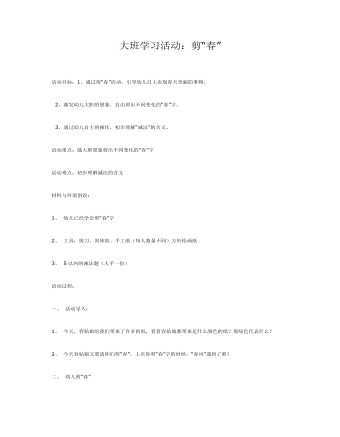
大班数学:剪“春”课件教案
2、激发幼儿大胆的想象,自由剪出不同变化的“春”字。 3、通过幼儿自主的操作,初步理解“减法”的含义。活动重点:能大胆想象剪出不同变化的“春”字活动难点:初步理解减法的含义材料与环境创设: 1、 幼儿已经学会剪“春”字2、 工具:剪刀、固体胶、手工纸(每人数量不同)方形铅画纸3、 5以内的减法题(人手一份)

